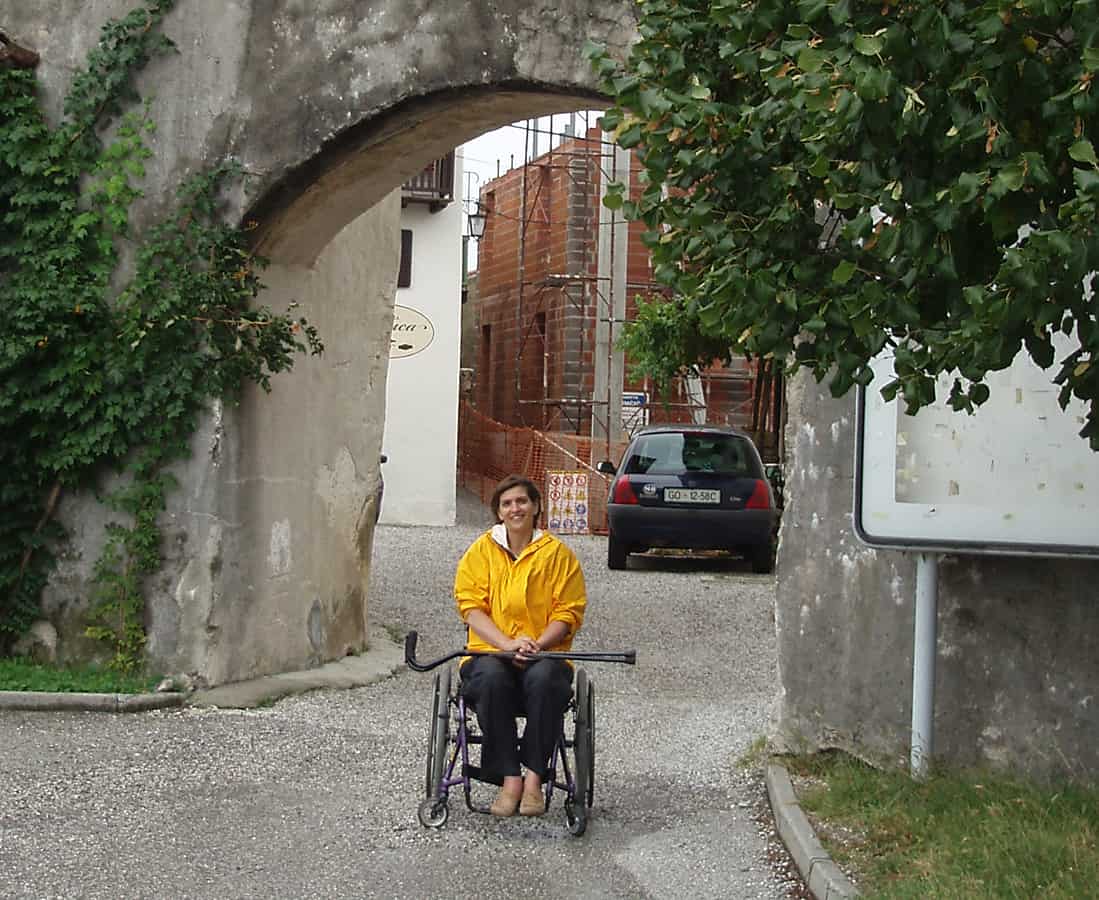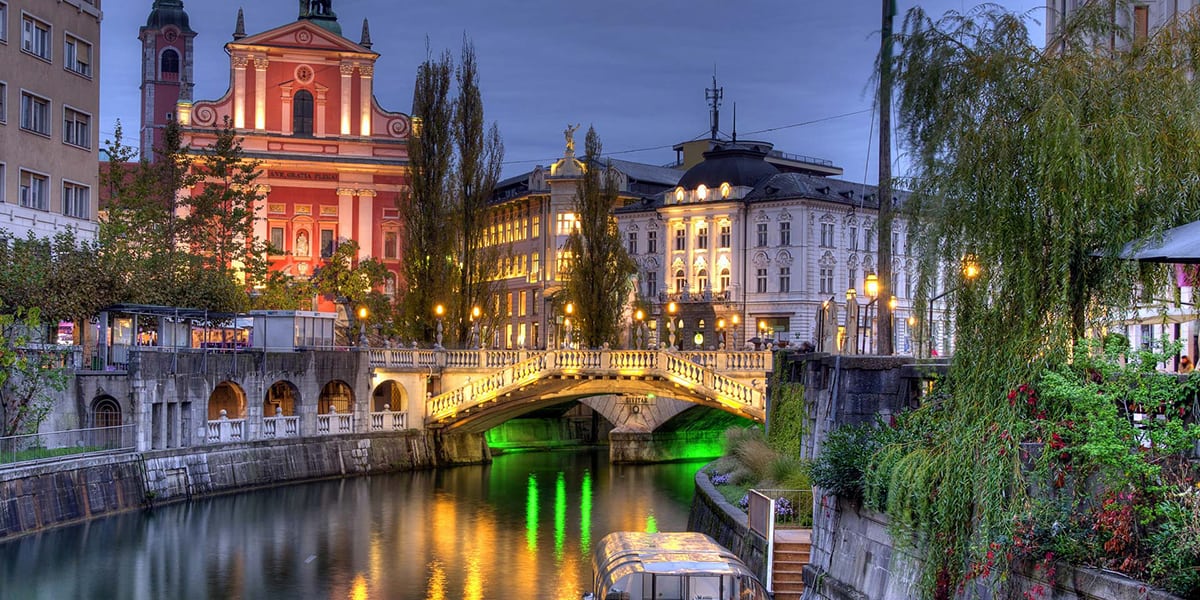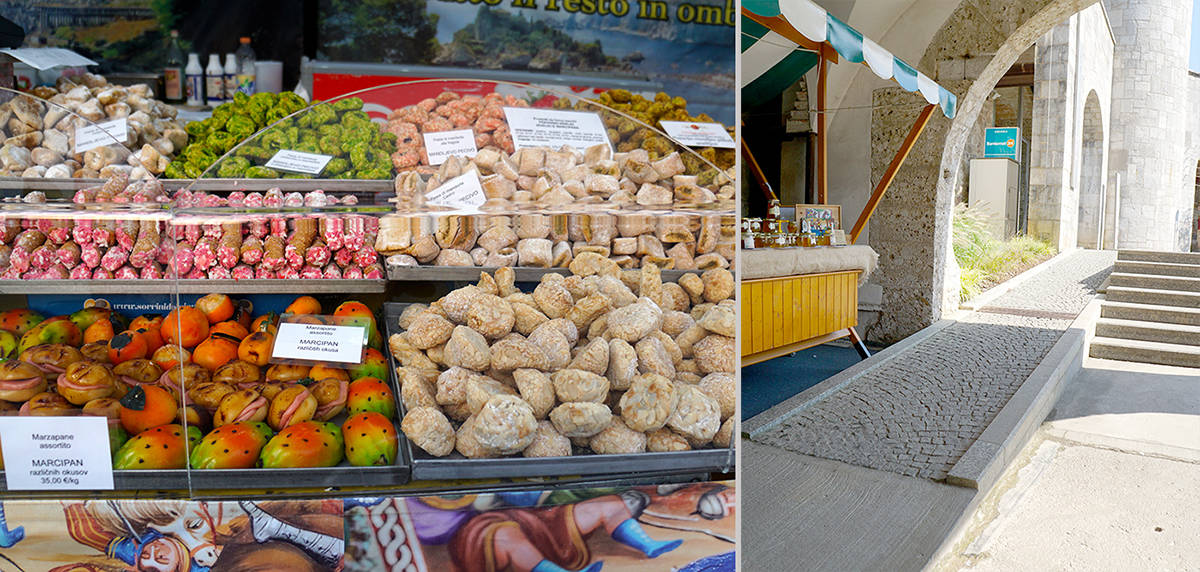Slovenia, a central-European country slightly smaller than the state of New Jersey, is tucked between Austria and Croatia north to south, and Hungary and Italy east to west. The Eastern Alps cover much of the northern part of the country, melting into rolling hills and green plains until reaching the west coast at the Adriatic Sea. Slovenia was the first nation to secede from Yugoslavia in 1991, claiming its independence and establishing a democratic government that continues today.
See also: |
Tourism became a focus for newly re-formed Slovenia. Much has been done over the past decades to welcome visitors of all abilities. A wheelchair-friendly certification program with many accessibility standards similar to our ADA recognizes communities that have gone the extra mile to make themselves wheelchair accessible. Curb cuts, ramps, accessible restrooms and other accommodations have been provided where feasible — even at historic sites — making this small, friendly nation surprisingly accommodating.
Miriam Zweizig, who is a T7-8 paraplegic and uses both a manual chair and canes for mobility, has visited three times. “I really like Slovenia a lot,” she says. “For such a small country, it has so many different environments — Alpine mountains, the Adriatic Sea by the border with Italy. And the capital city of Ljubljana is a very nice-sized city.” Zweizig is a translator and her husband teaches Slovenian at the University of Washington. “Visiting Slovenia comes with the package,” she laughs.
In addition to the unique environments Zweizig mentioned, Slovenia has significant limestone caves, caverns and underground rivers in the Karst region. The geologic term “Karst topography” derived its origin from this very place.
Ljubljana: The Accessible Capital
Ljubljana, the capital, is not only worth seeing, it is a good place to stay. Bike paths, curb cuts and accessible buses make it easy to navigate here. There are even green-space parks, complete with wheelchair accessible swings. The “Old Town” district has beautiful architecture in a variety of styles, echoing Slovenia’s history of occupations and reconstructions over centuries, from Medieval days starting as an outpost during Roman occupation, then adding Gothic arches, then Baroque-style buildings, followed by Venetian and Vienna Secession styles.
Ljubljana Castle, an example of Romanesque-turned-Gothic and Renaissance architectures, is now a magnificent history museum. Sitting atop a high hill, it overlooks the beautiful, rolling green foothills of the Alps. The exhibits display centuries of rich history, beginning with prehistoric through Roman times, continuing to the Middle and Early Modern Ages, then World War I, World War II, the Yugoslavian era, ending with independent Slovenia. “I found access good for places like museums,” Zweizig says, “even in smaller towns.”
Kelly Narowski, a professional speaker, military spouse and avid traveler, visited Ljubljana in September 2016. “I judge accessibility on if I can do it by myself, and I think with good planning, I could have in Ljubljana,” says Narowski, who traveled with her husband.
Both Zweizig and Narowski toured Ljubljana Castle.
“I went to everything — the puppet museum, the chapel. All of the grounds were accessible except the tower,” says Narowski, who sustained a T6 complete spinal cord injury from a car crash in 1998. She often uses her “cobblestone chair” when traveling — a manual chair modified with oversized casters and wheels.
“I asked if the castle tour was wheelchair accessible, and the tour guide just took a little different route so I could get around,” she says. “It was my biggest accessibility surprise by far in Slovenia.“
Narowski praised those who modified Ljubljana Castle. “They were so cognizant of accessibility. Ramps were built within the grounds and they blended in … they even added accessible bathrooms. How many castles have accessible bathrooms? I wasn’t expecting that.”
Another worthwhile stop in Ljubljana is the Slovenian Ethnographic Museum. “I particularly liked this cultural museum,” says Zweizig. The completely accessible facility is “for the people, about the people” and compares traditions and cultures of the Slovenians with that of peoples who influenced their nation.
Slovenians have a reputation for being both well-read and multilingual, often speaking five languages. The Ethnographic Museum documents the varied cultures within their region, which took planning and effort. It is now preserved in the Ethnographic Museum.
Accessing the Alps
The centralized location of Ljubljana and its many truly wheelchair-friendly hotels make it a great location from which to explore the country.
“Slovenia is so small, it is only a four-hour drive from one side to the other,” says Vesna Susic Palmisano, a native Slovenian who uses a power chair for mobility due to spinal muscular atrophy. “We say ‘you can go skiing in the morning and have dinner by the sea in the evening.’ It’s great, really.”
Several ski resorts are in the Triglav National Park region in the Julian Alps by the Slovenian-Austrian border. Skipass Hotel in Kranjska Gorda is an hour’s drive northwest of Ljubljana. Professional skiers are available and eager to help anyone who brings a mono-ski and is keen on skiing the Alps.

Triglav National Park, established in 1924, is one of Europe’s oldest national parks. It is highly protected and remains largely unspoiled. Four hundred mountains over 6,500 feet in elevation lie within Triglav, Slovenia’s only national park. At 9,396 feet, Mount Triglav is the highest peak. The valley town of Trenta in the park region is a nicely accessible community along the Soca River. The Trenta Lodge is wheelchair-friendly, as is the Trenta Museum with exhibits on folklore, culture, heritage and mountaineering.
Also in the Triglav region is famous Lake Bled, which has served as the venue for the World Rowing Championship multiple times. This 358-acre glacial lake is truly picturesque. “It’s like something out of a fairy tale,” says Narowski. “The 10-mile path around Lake Bled is almost completely wheelchair accessible except for a short length of gravel.” Bled Castle, one of the oldest in Europe, overlooks the lake and is wheelchair-friendly. The history of Bled, dating back to 1011, is housed and exhibited here.
Lake Bled harbors Bled Island, the only natural island in Slovenia. Pilgrimage Church of the Assumption of Maria is built on the island. Tourists arrive via paddle boats. “They aren’t accessible, but a man, without even discussing it, helped my husband pick me up into the boat,” Narowski says.
Zweizig stayed in the town of Bled instead of going to the island. “I thought it was really pretty. The town of Bled is certainly a beautiful place.” Neither Narowski nor Zweizig was able to ascend the 55 steps to enter the church.
Thermal Spas Slovenian-Style
Palmisano describes over a dozen natural hot spring spas sprinkled throughout the country, some in the Alps on the north and northeast sides of the country, and others in the seaside towns. “Slovenia is known for its thermal spas,” Palmisano says, “and most are wheelchair accessible.”
In the Panonic region near the mountain town of Maribor — one of the award recipients of Slovenia’s wheelchair-friendly certification program — the thermal spa of Terme 3000 Moravske Toplice resides. It provides more than 10 wheelchair accessible rooms in its three-hotel resort, and 14 pools, the largest of which is accessible by lift. Additional family fun includes a golf course, walking trails and excellent cuisine.
In Maribor, the Regional Museum Maribor is wheelchair-friendly, including restrooms. Part of the museum is housed in Maribor Castle, completed in 1483 by Holy Roman Emperor Frederick III. The museum exhibits focus on the regional history, as this region was occupied by Rome, Germany, Austria and Slovenia over the centuries. Archeology, ethnology, and the comprehensive cultural heritage of this area is also preserved here.
Along the 28-mile coast of the Adriatic Sea, a series of small villages are linked by a wheelchair-accessible bike trail. Palmisano describes a spa and beach operated by the Slovenian Muscular Dystrophy Association. “There is a spa in Izola that has great access to the sea and a heated swimming pool with sea water. Bathing attendants can help you in and out of the water. Also there are accessible showers and toilet. You can book a room, have PT and, if needed, personal care — it’s very nice when traveling and not so expensive.”
Tourists are welcomed to book a room, just like in a regular hotel. A similar center, also in Izola, run by the Slovenian Paraplegic Association, has a nice pool but no beach access.
Great Wine and Caves and the Karst Region
Spanning the vine-covered hills one-hour’s drive north of Izola is the town of Goriska Brda. “It’s wine country,” Zweizig says. “It has all these little castle towns. It’s really pretty and even has accessible bed-and-breakfasts.”
The green hills are dotted with wineries and tasting rooms, many wheelchair-friendly. Zweizig, Narowski and Palmisano all compare the wine produced in this region to that of Tuscany, Italy. “I didn’t know they had wine in Slovenia,” says Narowski. “It was really good. I bought four or five bottles of it.”
“You can visit all year round or come for the Cherry Festival or in the grape picking season,” adds Palmisano. Some of the most famous wine cellars in the region that are wheelchair-friendly include Klet Dobrovo and Movia.
Near Goriska Brda is the Karst region, a 166-square-mile plateau between the Vipava Valley and the Adriatic Sea. Among worthwhile sites in this area is the most visited cave in Europe, Postonja Cave, a network of nearly 15 miles of passages, caverns and chambers, which is served by a train. Visitors with mobility needs can view the wealth of calcite formations, stalactites and stalagmites from the train since the cave itself is difficult to navigate.

Another must-see in the Karst region is the Lipizzan Stud Farm in Lipica. “The farm is completely wheelchair accessible,” Palmisano confirms. “You can take a tour and see a performance of the classic riding school.” Austrian royalty began breeding white Lipizzan horses for agility, intelligence and sturdiness over 430 years ago. The official horse of the Spanish Riding School of Vienna, these intelligent and graceful horses are used exclusively for teaching classical horsemanship in its purest form. The 768-acre estate includes a wheelchair accessible tour of the Manor house, Cernigoj Art Gallery, Lipizzaner Museum, Carriage Museum, Chapel, and three miles of accessible nature trails.
A Gracious People
“If you come to Slovenia, it’s impossible to get lost because everybody speaks English, even in small villages,” says Palmisano. That certainly provides added comfort, as Slovenian is not the easiest of languages to learn. “Here, when we go to school, we have English, Italian and then we can choose French or German — a third language besides Slovenian.” This ups the odds of good communication in a country building its tourist trade. The foresight of Slovenia to provide wheelchair access nationwide puts them ahead of many countries vying for tourist dollars.
The friendliness of the Slovenian people is a strong asset, as well. “There’s never been a situation that we couldn’t find help,” says Zweizig. “It’s been very easy to make friends there. It’s not uncommon for them just to say ‘Hey, we have this cottage up in the mountains. If you want to go visit it, you’re welcome to.’” Zweizig and her husband plan to make more frequent trips to Slovenia and enjoy the company of their new friends.
“We loved it,” says Narowski. “We wished we had a couple more days there. I would totally go back.”
Resources
Ljubljana, www.visitljubljana.com/en/visitors/
Thermal Spas, www.slovenia.info/en/Thermal-spas.htm?term_kopalisce=0&lng=2
Spa of Slovenian MDA, www.dom2topola.si/#
Slovenian Paraplegic Association, zveza-paraplegikov.si/eng/
Spa of Slovenian Paraplegic Association, www.domparaplegikov.si/
Bled, www.bled.si/en/about-bled
Triglav National Park, www.tnp.si/national_park/
Wine Country of Goriska Brda, www.brda.si/eng/
Lipica Stud Farm, www.lipica.org/en/discover-lipica
Accessible Wineries:
Klet Dobrovo, klet-brda.si/en/
Movia, www.movia.si/en/hisa-movia
Ljubljana and SCI Research
by Tim Gilmer
With its ancient history and architecture, Slovenia may seem like a destination to be avoided by wheelchair users. But even prior to seceding from Yugoslavia in 1991, this nation’s capital city, Ljubljana, had a reputation for its independent ways and ties to the western world — in particular, paraplegics.
Ljubljana played an important role in the development of functional electrical stimulation, forerunner of today’s most exciting spinal cord injury research protocol — epidural stimulation [see “Mayo Clinic Epidural Stimulation Trial”, News]. In 1971, I made plans to visit the city, while traveling in Europe, with the purpose of meeting researchers at the University of Ljubljana. At 26, just six years post-injury, I was interested in possibly participating in their experimental research, which had enabled a complete paraplegic to stand without braces for the first time.
A friend and I traveled by train, across the Alps, from Munich to Ljubljana. Our specific destination was a then-modern lab dedicated to the emerging field of biomedical research. I was to meet with Lojze Vodovnik, the lead researcher, but on the day I arrived, he was busy at a conference. I met instead with an American researcher, part of the project’s international team.
In the lab I scrutinized the “state-of-the-art” setup — an old-style oscilloscope, a mainframe computer, wires with electrode patches. The only essential research element that was the same then as it is today was the subject — a paralyzed person with hopes of one day standing and walking.
As it turned out, I had to return to the United States due to a serious family illness. Now, 46 years later and 72 years old, I am still waiting for my turn — but not holding my breath.
Support New MobilityWait! Before you wander off to other parts of the internet, please consider supporting New Mobility. For more than three decades, New Mobility has published groundbreaking content for active wheelchair users. We share practical advice from wheelchair users across the country, review life-changing technology and demand equity in healthcare, travel and all facets of life. But none of this is cheap, easy or profitable. Your support helps us give wheelchair users the resources to build a fulfilling life. |






Recent Comments
Kelly DeBardelaben on Tips to Maintain Bowel Regularity with SCI When You Travel
Glen Gregos on Traveling With and Without a Caregiver
Sue on Controller Recall Puts SmartDrive Safety in the Spotlight